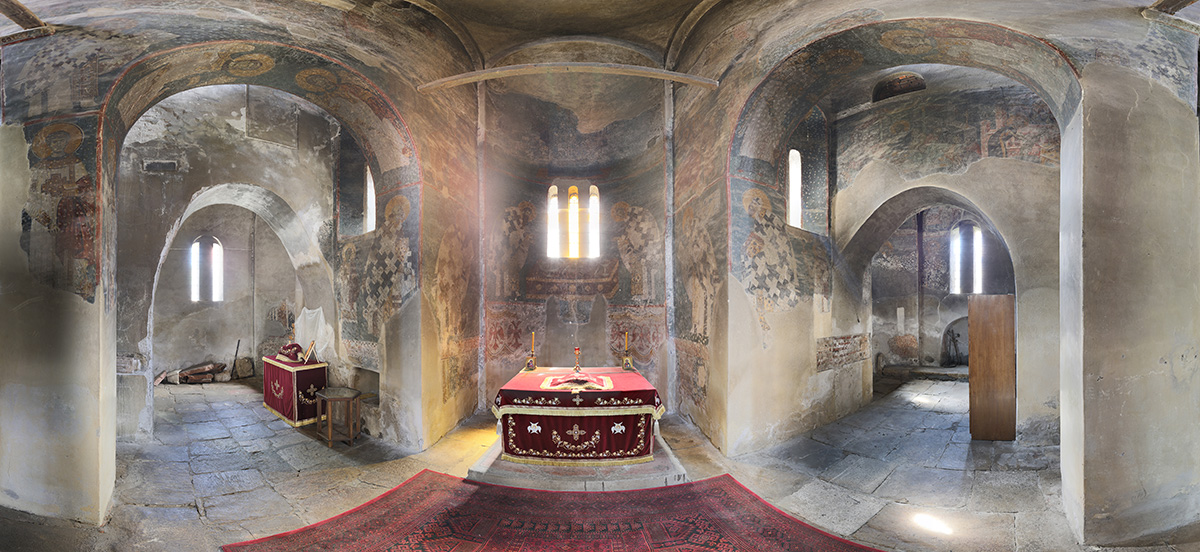In addition to the building remains, fragments of the altar partition with shallow relief decoration from the 13th century are also preserved, as well as frescoes from the southern aisle: fresco-icon of the Virgin Mary of Eleusa with Christ the Protector (the Guardian), and partially preserved compositions of the Wedding in Cana and Healing (preserved today at the National Museum in Belgrade) from the series of the miracles of Christ.
In the fourteenth century, the church was remodeled into a five-nave basilica incorporating the plan of a developed inscribed cross, while a five-domed solution was constructed above. On the west side, an open-sided two-story narthex was raised, topped by a bell tower. The facades of the church are made of stone and brick, in the so-called cellular style, with lavish use of ceramic tile decoration.
The fresco-icon of Theotokos Eleusa (1308-1313) is the work of a studio led by a proto-master from the Thessaloniki family Astrapa, Evtihia, or his son Michael, who later worked for King Milutin. It is distinguished by the exceptional thematic richness and belongs to the artistic direction, Renaissance Paleologists. The central dome features the bust of Christ the Sovereign, surrounded by angels, while the four small domes house various aspects of the image of Christ. The prophets and ancestors of Christ are depicted in tambourines and evangelicals in pendentives.
The sanctuary area contains frescos of the Theotokos, officiating Church Fathers, the Ascension of Christ, and the Communion of the Apostles. Frescos of the Theotokos of Ljevis covers several cycles: the Great Feasts, the Work of Christ and Miracles, the Suffering, as well as the Posthumous Announcements. The cycle of Saint Nicholas is painted in the southern nave, where the Ecumenical Councils are also located, and the lives of Saint Dimitri and George are in the chapels upstairs of the outer quays. The columns are adorned with figures of martyrs, holy warriors, and physicians, as well as the remarkable performances of many holy women (Barbarians, Theodosius, Sunday, Friday, etc.). At the same time, apostles Peter and Paul are shown in the passage between the parish and the nave.
Separate figures in the first zone include murals of the Virgin Mary of the Orphan and Christ, the Guardian of Prizren. Nemanjic’s plays are in the parade. A formal portrait of King Milutin is painted on its eastern wall. On the other side of the entrance to the nave, also under the blessing of Christ, once stood the figure of King Uros, Milutin’s father. On the opposite side, west wall of the nave, is the bust of St. Simeon Nemanja, who, as a monk, spread his hands in prayer and surrounded by sons – St. Sava, dressed in a luxurious sack and accompanied by a priestess, and Stefan the Firstcrowned, and the future King Stefan Decanski, son of Milutin.
Cathedral of Prizren also features some rarely painted scenes, such as the play of the Canon of the Assumption of the Virgin Mary of Damascus in the outer parable, and episodes about the man and unicorn from the Novel of Varlaam and Joasaph on the narthex floor, and remarkable personifications of the Old and New Testaments in the form of winged girls at the entrance to the narthex floor. On the western wall of the narthex, during the Turkish rule, a visitor, amazed by the frescoes of the Theotokos of Eleusa, wrote in an Arabic script the verse of the Persian poet Hafiz: “The pupil of my eye is your nest.”
The city cathedral was transformed into a mosque during Turkish rule over Prizren, and its paintings were damaged and covered with mortar. The Orthodox Christian service was restored after the First Balkan War. Conservation and restoration works were carried out there in 1950–1952. In the riots in March of 2004, when all the Prizren Orthodox churches were destroyed, icon-fresco of the Theotokos of Eleusa was damaged by fire. The conservation work on the painting in 2011-2013 was carried out by Italian experts and continued by the Serbian Institute for the Protection of Cultural Monuments. Since 2006, the Virgin Mary Ljeviška, along with the Patriarchate of Pec, Gracanica, and Decani, has been on the UNESCO World Heritage List as well as on the World Heritage List at risk. The church is closed today, cordoned by the barbed wire, and under 24-hour protection.














